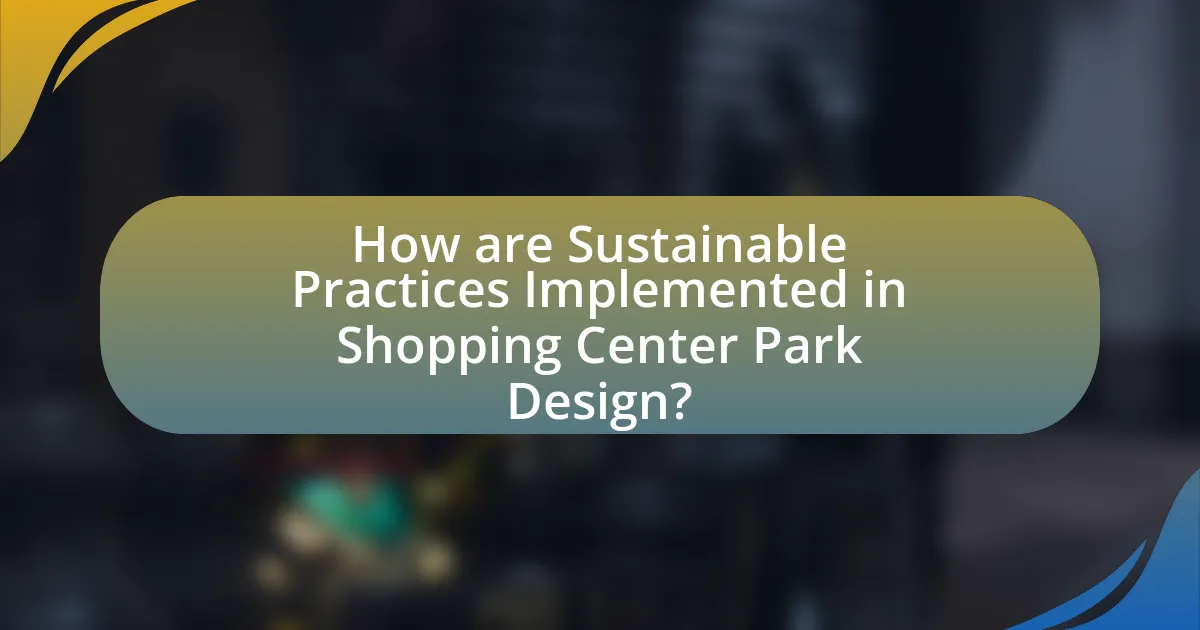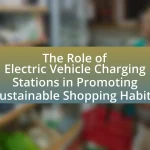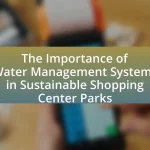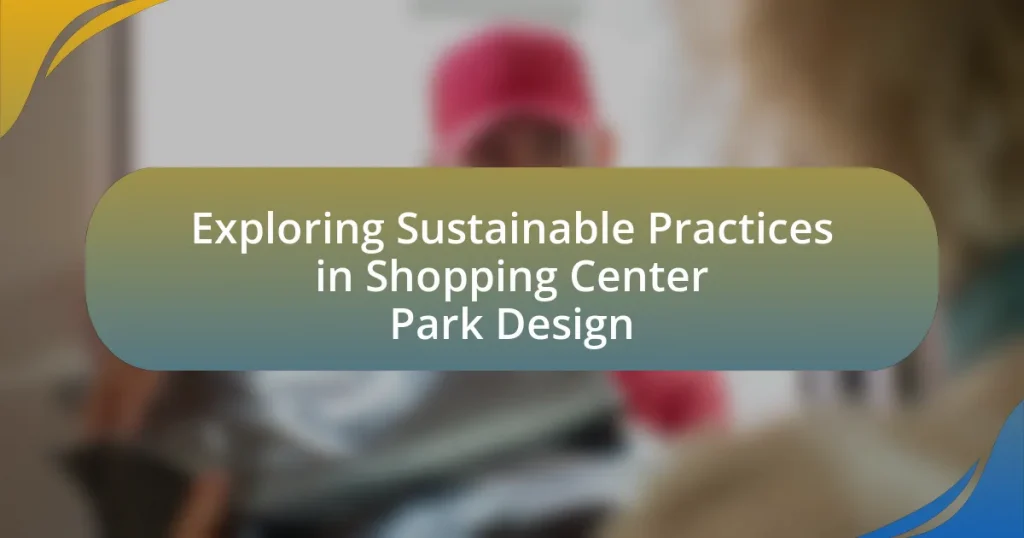The article focuses on sustainable practices in shopping center park design, emphasizing the integration of native landscaping, efficient water management systems, and renewable materials. It highlights the importance of sustainability in minimizing environmental impact, enhancing community well-being, and addressing issues such as resource depletion and pollution. Key elements discussed include site selection, community engagement, and the use of smart technologies, all aimed at creating functional green spaces that improve the shopping experience. The article also outlines the benefits of sustainable parks, including economic advantages, social cohesion, and health improvements for communities.

What are Sustainable Practices in Shopping Center Park Design?
Sustainable practices in shopping center park design include the integration of native landscaping, efficient water management systems, and the use of renewable materials. Native landscaping reduces the need for irrigation and maintenance, promoting biodiversity and resilience. Efficient water management systems, such as rain gardens and permeable pavements, help manage stormwater runoff and reduce flooding risks. The use of renewable materials, like reclaimed wood and recycled metals, minimizes environmental impact and supports a circular economy. These practices not only enhance the ecological value of shopping centers but also improve the overall shopping experience by creating attractive, functional green spaces.
Why is sustainability important in shopping center park design?
Sustainability is crucial in shopping center park design because it minimizes environmental impact while enhancing community well-being. Sustainable practices, such as using native plants and efficient water management systems, reduce resource consumption and promote biodiversity. For instance, a study by the U.S. Green Building Council found that green spaces in urban areas can lower temperatures by up to 5 degrees Fahrenheit, improving air quality and reducing energy costs. Additionally, incorporating sustainable design elements can increase foot traffic and customer satisfaction, as consumers increasingly prefer eco-friendly spaces.
What environmental impacts are addressed by sustainable practices?
Sustainable practices address several environmental impacts, including resource depletion, pollution, and biodiversity loss. By implementing strategies such as energy efficiency, waste reduction, and sustainable sourcing, these practices mitigate the overuse of natural resources, reduce greenhouse gas emissions, and promote the conservation of ecosystems. For instance, the use of renewable energy sources in shopping center park design can significantly lower carbon footprints, while rainwater harvesting systems can minimize water waste. Studies indicate that sustainable landscaping can enhance local biodiversity by providing habitats for various species, thereby supporting ecological balance.
How do sustainable practices enhance community well-being?
Sustainable practices enhance community well-being by promoting environmental health, social equity, and economic viability. These practices, such as using native plants in landscaping and implementing green infrastructure, improve air and water quality, which directly benefits public health. For instance, a study by the American Public Health Association found that green spaces can reduce stress and improve mental health outcomes in urban populations. Additionally, sustainable practices foster community engagement and social cohesion by creating inclusive spaces that encourage interaction among residents. This is supported by research from the University of Illinois, which indicates that well-designed parks can increase community involvement and enhance the quality of life. Therefore, the integration of sustainable practices in shopping center park design not only addresses ecological concerns but also significantly contributes to the overall well-being of the community.
What principles guide sustainable park design in shopping centers?
Sustainable park design in shopping centers is guided by principles such as ecological integrity, community engagement, and resource efficiency. Ecological integrity emphasizes the preservation of local biodiversity and ecosystems, ensuring that park designs incorporate native plants and habitats that support wildlife. Community engagement involves involving local stakeholders in the design process to create spaces that meet the needs and preferences of the community, fostering a sense of ownership and responsibility. Resource efficiency focuses on minimizing water and energy use through sustainable landscaping practices, such as xeriscaping and the use of renewable energy sources. These principles collectively contribute to creating parks that are not only environmentally friendly but also enhance the shopping center’s appeal and functionality.
How does site selection contribute to sustainability?
Site selection significantly contributes to sustainability by determining the environmental impact and resource efficiency of a project. Choosing locations that minimize disruption to ecosystems, reduce transportation emissions, and utilize existing infrastructure leads to lower carbon footprints. For instance, a study by the U.S. Environmental Protection Agency indicates that developing on previously disturbed land can preserve natural habitats and reduce urban sprawl, which is essential for maintaining biodiversity. Additionally, selecting sites with access to public transportation encourages sustainable commuting options, further enhancing the project’s overall sustainability profile.
What role does native landscaping play in sustainable design?
Native landscaping plays a crucial role in sustainable design by promoting biodiversity and reducing resource consumption. This approach utilizes indigenous plant species that are well-adapted to local climates and soil conditions, which minimizes the need for irrigation, fertilizers, and pesticides. Research indicates that native plants can support local wildlife, including pollinators, thereby enhancing ecosystem health. For instance, a study published in the journal “Ecological Applications” found that landscapes with native vegetation can increase species richness by up to 50% compared to non-native landscapes. This evidence underscores the importance of native landscaping in achieving sustainable design objectives.
What are the key elements of sustainable shopping center parks?
The key elements of sustainable shopping center parks include green infrastructure, energy efficiency, water conservation, biodiversity enhancement, and community engagement. Green infrastructure, such as permeable pavements and green roofs, helps manage stormwater and reduce urban heat. Energy efficiency is achieved through the use of renewable energy sources and energy-efficient lighting. Water conservation practices, like rainwater harvesting and drought-resistant landscaping, minimize water usage. Biodiversity enhancement involves creating habitats for local wildlife, which supports ecosystem health. Lastly, community engagement ensures that the park meets the needs of local residents and fosters a sense of ownership, leading to better maintenance and sustainability outcomes.
How can water management systems be designed sustainably?
Water management systems can be designed sustainably by integrating green infrastructure, such as rain gardens and permeable pavements, which enhance natural water filtration and reduce runoff. These systems utilize native vegetation to absorb and filter stormwater, thereby minimizing pollution and conserving water resources. Research indicates that implementing green roofs can reduce stormwater runoff by up to 65%, demonstrating their effectiveness in sustainable design. Additionally, incorporating smart technology for monitoring water usage and quality can optimize resource management and ensure compliance with environmental standards.
What materials are best for sustainable park construction?
Recycled materials, native plants, and permeable paving are the best materials for sustainable park construction. Recycled materials, such as reclaimed wood and recycled plastic, reduce waste and lower the carbon footprint associated with new material production. Native plants require less water and maintenance, promoting biodiversity and resilience in local ecosystems. Permeable paving allows for natural water drainage, reducing runoff and improving groundwater recharge. These materials collectively contribute to environmentally friendly park designs that align with sustainable practices.

How are Sustainable Practices Implemented in Shopping Center Park Design?
Sustainable practices in shopping center park design are implemented through strategies such as the use of native landscaping, efficient water management systems, and renewable energy sources. Native landscaping reduces the need for irrigation and chemical fertilizers, promoting biodiversity and ecosystem health. Efficient water management systems, including rainwater harvesting and permeable paving, minimize runoff and conserve water resources. Additionally, integrating renewable energy sources like solar panels can reduce the carbon footprint of the shopping center. These practices not only enhance environmental sustainability but also improve the overall aesthetic and functionality of the shopping center park, aligning with modern urban design principles.
What steps are involved in the planning phase for sustainable parks?
The steps involved in the planning phase for sustainable parks include site assessment, stakeholder engagement, design development, and implementation planning. Site assessment involves evaluating the ecological, social, and economic conditions of the area to identify opportunities and constraints. Stakeholder engagement ensures that the needs and preferences of the community and other interested parties are considered, fostering support for the project. Design development focuses on creating a layout that incorporates sustainable practices, such as native plant selection and water management systems. Implementation planning outlines the timeline, budget, and resources needed to execute the project effectively. These steps are essential for creating parks that are environmentally responsible and beneficial to the community.
How can stakeholder engagement improve sustainability outcomes?
Stakeholder engagement can significantly improve sustainability outcomes by fostering collaboration and ensuring that diverse perspectives are considered in decision-making processes. Engaging stakeholders, such as community members, local businesses, and environmental organizations, leads to more informed and inclusive strategies that address specific sustainability challenges. For instance, a study by the International Council for Local Environmental Initiatives found that cities with active stakeholder participation in urban planning achieved better environmental performance and community satisfaction. This evidence demonstrates that when stakeholders are involved, the resulting sustainability initiatives are more likely to be effective and widely supported.
What tools are available for assessing sustainability in design?
Tools available for assessing sustainability in design include Life Cycle Assessment (LCA), Sustainability Assessment Frameworks, and Building Information Modeling (BIM). Life Cycle Assessment evaluates the environmental impacts of a product or service throughout its life cycle, providing quantitative data that informs design decisions. Sustainability Assessment Frameworks, such as the LEED (Leadership in Energy and Environmental Design) certification, offer structured guidelines for measuring sustainability in building projects. Building Information Modeling enhances design efficiency by integrating sustainability metrics into the design process, allowing for real-time analysis of environmental impacts. These tools are widely recognized in the field and are essential for promoting sustainable practices in design, particularly in shopping center park design.
What technologies support sustainable practices in park design?
Technologies that support sustainable practices in park design include green infrastructure, renewable energy systems, and smart irrigation technologies. Green infrastructure, such as permeable pavements and rain gardens, helps manage stormwater and reduce urban heat. Renewable energy systems, like solar panels and wind turbines, provide clean energy for park facilities, minimizing carbon footprints. Smart irrigation technologies utilize sensors and weather data to optimize water usage, promoting efficient resource management. These technologies collectively enhance ecological health and sustainability in park environments.
How do renewable energy sources integrate into park design?
Renewable energy sources integrate into park design by incorporating solar panels, wind turbines, and geothermal systems to provide sustainable energy for park facilities and amenities. For instance, solar panels can be installed on park buildings or structures to power lighting, restrooms, and visitor centers, reducing reliance on non-renewable energy. Wind turbines can be strategically placed in open areas of the park to harness wind energy, contributing to the park’s overall energy needs. Additionally, geothermal systems can be utilized for heating and cooling purposes in park facilities, enhancing energy efficiency. These integrations not only promote sustainability but also serve as educational tools, demonstrating the benefits of renewable energy to park visitors.
What role does smart technology play in park management?
Smart technology enhances park management by improving operational efficiency, visitor experience, and environmental sustainability. For instance, smart sensors can monitor soil moisture and weather conditions, allowing for optimized irrigation and resource management, which reduces water waste. Additionally, mobile applications can provide real-time information to visitors about park events, amenities, and safety alerts, thereby increasing engagement and satisfaction. Research indicates that parks utilizing smart technology can achieve up to 30% reductions in maintenance costs and resource consumption, demonstrating its effectiveness in promoting sustainable practices in park management.
What challenges are faced in implementing sustainable practices?
Implementing sustainable practices faces several challenges, including financial constraints, lack of stakeholder engagement, and regulatory hurdles. Financial constraints often limit the ability of shopping centers to invest in sustainable technologies and infrastructure, as initial costs can be high. Lack of stakeholder engagement, including insufficient collaboration among developers, local governments, and the community, can hinder the adoption of sustainable practices. Regulatory hurdles, such as complex zoning laws and building codes, can create barriers to implementing innovative sustainable solutions. These challenges are supported by studies indicating that financial limitations are a primary barrier for 70% of businesses attempting to adopt sustainability measures, while stakeholder engagement is crucial for successful implementation, as highlighted in research by the World Resources Institute.
How can budget constraints impact sustainable design choices?
Budget constraints can significantly limit sustainable design choices by restricting the selection of eco-friendly materials and technologies. When financial resources are limited, designers may opt for cheaper, less sustainable options that do not prioritize environmental impact. For instance, a study by the U.S. Green Building Council found that projects with tighter budgets often forego energy-efficient systems and renewable energy sources, which can lead to higher long-term operational costs and environmental degradation. Consequently, budget limitations can hinder the implementation of innovative sustainable practices in shopping center park design, ultimately affecting the overall sustainability of the project.
What are common misconceptions about sustainable park design?
Common misconceptions about sustainable park design include the belief that it is solely about using native plants and reducing water usage. While these elements are important, sustainable park design also encompasses a holistic approach that integrates biodiversity, community engagement, and ecological health. For instance, many assume that sustainable parks require minimal maintenance, but in reality, they often need ongoing care to ensure ecological balance and community involvement. Additionally, some people think that sustainable parks are more expensive to create, yet studies show that they can lead to long-term cost savings through reduced energy and water use, as well as increased property values in surrounding areas.

What are the Benefits of Sustainable Practices in Shopping Center Park Design?
Sustainable practices in shopping center park design provide environmental, economic, and social benefits. Environmentally, these practices reduce resource consumption and minimize waste, leading to lower carbon footprints; for instance, using native plants can decrease water usage by up to 50%. Economically, sustainable designs can enhance property values and attract more visitors, as studies show that green spaces can increase foot traffic by 20%. Socially, they promote community well-being by offering recreational spaces that improve mental health and foster social interactions, evidenced by research indicating that access to green spaces can reduce stress levels significantly.
How do sustainable parks enhance the shopping experience?
Sustainable parks enhance the shopping experience by creating inviting environments that promote relaxation and social interaction. These parks often incorporate green spaces, which have been shown to reduce stress and improve mood, leading to longer shopping visits. Research indicates that shopping centers with integrated parks can see a 20% increase in foot traffic, as consumers are drawn to the aesthetic and recreational opportunities provided by these natural areas. Additionally, sustainable parks contribute to environmental benefits, such as improved air quality and biodiversity, which can enhance the overall appeal of the shopping destination.
What economic benefits arise from sustainable park design?
Sustainable park design generates significant economic benefits, including increased property values, reduced infrastructure costs, and enhanced tourism revenue. Research indicates that parks designed with sustainability in mind can lead to a 20% increase in nearby property values due to improved aesthetics and recreational opportunities. Additionally, sustainable parks often require less maintenance and lower water usage, resulting in reduced long-term operational costs for municipalities. Furthermore, these parks attract visitors, boosting local businesses and generating additional tax revenue; for instance, a study by the National Recreation and Park Association found that every dollar invested in parks yields approximately four dollars in economic return through tourism and local spending.
How do sustainable parks contribute to brand image for shopping centers?
Sustainable parks enhance the brand image of shopping centers by demonstrating a commitment to environmental responsibility and community well-being. This commitment attracts eco-conscious consumers, as studies show that 66% of global consumers are willing to pay more for sustainable brands. Additionally, sustainable parks improve the aesthetic appeal and functionality of shopping centers, creating inviting spaces that encourage longer visits and increased foot traffic. Research from the University of California indicates that green spaces can increase property values by up to 20%, further solidifying the positive perception of the shopping center brand.
What social benefits do sustainable parks provide to communities?
Sustainable parks provide numerous social benefits to communities, including enhanced community cohesion, improved mental health, and increased recreational opportunities. These parks serve as gathering spaces that foster social interactions and strengthen community ties, as evidenced by studies showing that access to green spaces can lead to higher levels of social engagement and community participation. Furthermore, sustainable parks contribute to mental well-being by offering environments that reduce stress and promote relaxation; research indicates that spending time in nature can lower anxiety and improve mood. Additionally, these parks offer diverse recreational activities, encouraging physical exercise and promoting healthier lifestyles among community members.
How do these parks promote social interaction and community engagement?
Parks promote social interaction and community engagement by providing accessible spaces for recreation, events, and gatherings. These areas often feature amenities such as playgrounds, picnic areas, and sports facilities that encourage people to come together for leisure activities. Research indicates that parks enhance community ties; for instance, a study by the National Recreation and Park Association found that 85% of respondents believe parks are essential for community cohesion. Additionally, organized events like farmers’ markets and outdoor concerts in parks foster connections among residents, further solidifying community bonds.
What health benefits are associated with green spaces in shopping centers?
Green spaces in shopping centers provide several health benefits, including improved mental well-being, reduced stress levels, and enhanced physical activity. Research indicates that exposure to greenery can lower cortisol levels, which are associated with stress, and promote relaxation. A study published in the journal “Environmental Science & Technology” found that individuals who spend time in green environments report higher levels of happiness and lower levels of anxiety. Additionally, green spaces encourage walking and other forms of physical activity, contributing to better cardiovascular health and overall fitness. The presence of trees and plants also improves air quality, which can lead to respiratory health benefits.
What are best practices for maintaining sustainable shopping center parks?
Best practices for maintaining sustainable shopping center parks include implementing native landscaping, utilizing efficient irrigation systems, and promoting biodiversity. Native plants require less water and maintenance, reducing resource consumption and supporting local ecosystems. Efficient irrigation systems, such as drip irrigation, minimize water waste and ensure plants receive adequate moisture. Additionally, incorporating features like rain gardens and permeable pavements helps manage stormwater runoff, enhancing sustainability. Research indicates that parks designed with these practices can reduce maintenance costs by up to 30% while improving environmental quality, as noted in the “Sustainable Landscape Management” study by the American Society of Landscape Architects.
How can ongoing community involvement support park sustainability?
Ongoing community involvement supports park sustainability by fostering a sense of ownership and responsibility among local residents. When community members actively participate in park maintenance, planning, and programming, they are more likely to advocate for sustainable practices, such as native plant landscaping and waste reduction initiatives. Research indicates that parks with strong community engagement experience improved ecological health and increased usage, as seen in studies conducted by the National Recreation and Park Association, which highlight that community-led efforts can lead to a 30% increase in volunteer participation for park clean-up events. This active involvement not only enhances the park’s environmental quality but also strengthens community ties, ensuring long-term commitment to sustainability efforts.
What maintenance strategies ensure long-term sustainability?
Maintenance strategies that ensure long-term sustainability in shopping center park design include regular landscape management, efficient irrigation systems, and the use of native plant species. Regular landscape management involves routine inspections and maintenance of plant health, which prevents overgrowth and disease, thereby promoting biodiversity. Efficient irrigation systems, such as drip irrigation, minimize water waste and ensure that plants receive adequate moisture, contributing to water conservation efforts. The use of native plant species is crucial as they are adapted to the local climate and soil conditions, requiring less maintenance and resources, which enhances ecological resilience. These strategies collectively support the sustainability of shopping center parks by reducing resource consumption and promoting environmental health.















